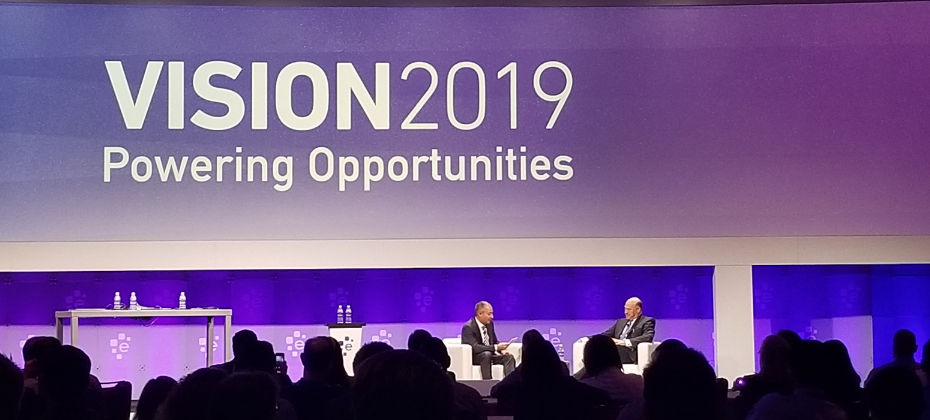Tag: fraud

“Experian is transforming our business from a traditional credit bureau to a true technology and software provider,” said Craig Boundy, CEO of Experian, North America, as part of his opening remarks Monday morning to kick off the 2019 Experian Vision Conference. “We are committed to working as a force of good.” Covering the themes of financial inclusion, giving consumers control of their lives and better outcomes, a digital-first society, and the latest trends in fraud and security, Boundy addressed a crowd of over 850. Alex Lintner, Experian’s Group President, gave a quick history of the past 3,000 years, from the first credit card, to the addition of wheels to a suitcase, to the iPhone and artificial intelligence. “Innovation is not invention,” Lintner said. He gave the example of the iPhone and how a tear down analysis revealed there were no new elements; however, it was the translation of an idea into a good or service that benefited everyone (as the entire audience raised their hand when asked who had a smart phone). Lintner’s mainstage presentation also featured three live demos, including how the Ascend Technology Platform takes complex model building and outputs from days and weeks to a few clicks, to the incorporation of Small Business Financial Exchange (SBFE) data into the Ascend Analytical Sandbox (incorporating more than 17 years of small business tradeline data and 150 predictive attributes) and lastly, Experian Boost, which according to a live tracker, has boosted consumer credit scores by a total of 3.2 million points, as of this morning, since its launch eight weeks ago. Keynote Speaker: Gary D. Cohn Gary D. Cohn, Former Director of the U.S. National Economic Council, was Monday morning’s keynote speaker. He weighed in on the domestic and global economy, policy issues, financial institutions’ responsibilities and some of his predictions. Cohn brought attention to the ever-changing financial services space, including new forms of encryption and the world of biometric security, calling the financial services industry the “tip of the spear” when it comes to the digitization of the world. Session Highlights - Day 1 Machine Learning From the building blocks of neural networks to artificial intelligence, machine learning has been used in the areas of financial services that do not have adverse actions – think fraud, ID, collections. As we look to harness machine learning for models and other spaces (including adverse action), it’s important to delineate descriptive data (what’s happening now); predictive data (what’s happening in the future); prescriptive data (what am I going to do now); and cognitive data (are we asking the right question?). In addition, it’s necessary to address the five advanced analytic drivers including customer experience, cost, risk and loss, growth and compliance. Home Equity & Lending US macroeconomic trends show consumer confidence is still on an upward trend. While investor confidence is a little volatile, the GDP remains strong (though slightly slowing down) and unemployment is low and forecasted to remain low. Since 2006, the US hasn’t returned in the HELOC space. Mortgage and personal loans are up 20% and 13% respectively, while mortgages have dropped 1% and HELOCs have dropped 2%. With an estimated market potential of over $700 billion, HELOCs may be an untapped credit line given the strength of the economy. Identity Evolution From dumpster divers, aka pulling receipts out of dumpsters behind businesses, to today’s identity-based authentication, there’s been an evolution of how identity is defined as well as its corresponding risks. According to Experian’s Global Fraud & Identity Report, 74% of consumers value security as the most important part of the online experience (over convenience and personalization). However, 74% of consumers abandoned a shopping session that required too much information, and 72% of consumers said they were willing to share more data if it meant a seamless experience. What does this mean? Consumers want it all. Identity today now includes proxies and activity, which can also mean greater risk. Because of aggregators and other associated entities acting on a consumer’s behalf, there are lots of nuances that will need to be looked through. Consumer-Permissioned Data In order to be more consumer-centric, there are four levers through which consumers are given control: data accuracy, knowing their financial profile, the ability to improve their scores (via Experian BoostTM and UltraFICOTM) and protecting consumers when they permission access to their identity credentials. Using Experian Boost, consumers have seen an average increase of 13 points for consumers with positive changes. Additionally, using alternative credit data, financial institutions can score more people and score more accurately. One hundred million consumers could gain greater access to credit with consumer-permissioned data sources. --- Meanwhile, the tech showcase featured over 20 demos covering alternative data, digital credit marketing, consumer empowerment, fraud and identity, integrated decisioning and technology. More insights from Vision to come. Follow @ExperianVision and #ExperianVision on Twitter to see more of the action.

For most businesses, building the best online experience for consumers requires a balance between security and convenience. But the challenge has always been finding a happy medium between the two – offering enough security that won’t get in the way of convenience and vice versa. In the past, it was always believed that one would always come at the expense of the other. But technology and innovation is changing how businesses approach security and is allowing them to give the maximum potential of both. Consumers want security AND convenience Consumers consider security and convenience as the foundation of their online experience. Findings from our 2019 Global Identity and Fraud Report revealed approximately 74 percent of consumers ranked security as the most important part of their online experience, followed by convenience. In other words, they expect businesses to provide them with both. We see this with how consumers are typically using the same security information each time they open a new digital account – out of convenience. But if one account is compromised, the consumer becomes vulnerable to possible fraudulent activity. With today’s technology, businesses can give consumers an easier and more secure way to access their digital accounts. Creating the optimal online experience More security usually meant creating more passwords, answering more security questions, completing CAPTCHA tests, etc. While consumers are willing to work through these friction-inducing methods to complete a transaction or access an account, it’s not always the most convenient process. Advanced data and technology has opened doors for new authentication methods, such as physical and behavioral biometrics, digital tokenization, device intelligence and machine learning, to maximize the potential for businesses to provide the best online experience possible. In fact, consumers have expressed greater confidence in businesses that implement these advanced security methods. Rates of consumer confidence in passwords was only 44 percent, compared to a 74 percent rate of consumer confidence in physical biometrics. Consumers are willing to embrace the latest security technology because it provides the security and convenience they want from businesses. While traditional forms of security were sufficient, advanced authentication methods have proven to be more reliable forms of security that consumers trust and can improve their online experience. The optimal online experience is a balance between security and convenience. Innovative technologies and data are helping businesses protect people’s identities and provide consumers with an improved online experience.

Be warned. I’m a Philadelphia sports fan, and even after 13 months, I still relish in the only Super Bowl victory I’ve ever known as a fan. Having spent more than two decades in fraud prevention, I find that Super Bowl LII is coalescing in my mind with fraud prevention and lessons in defense more and more. Let me explain: It’s fourth-down-and-goal from the one-yard line. With less than a minute on the clock in the first half, the Eagles lead, 15 to 12. The easy option is to kick the field goal, take the three points and come back with a six-point advantage. Instead of sending out the kicking squad, the Eagles offense stays on the field to go for a touchdown. Broadcaster Cris Collingsworth memorably says, “Are they really going to go for this? You have to take the three!” On the other side are the New England Patriots, winners of two of the last three Super Bowls. Love them or hate them, the Patriots under coach Bill Belichick are more likely than any team in league history to prevent the Eagles from scoring at this moment. After the offense sets up, quarterback Nick Foles walks away from his position in the backfield to shout instructions to his offensive line. The Patriots are licking their chops. The play starts, and the ball is snapped — not to Foles as everyone expects, but to running back Corey Clement. Clement takes two steps to his left and tosses the ball the tight end Trey Burton, who’s running in the opposite direction. Meanwhile, Foles pauses as if he’s not part of the play, then trots lazily toward the end zone. Burton lobs a pass over pursuing defenders into Foles’ outstretched hands. This is the “Philly Special” — touchdown! Let me break this down: A third-string rookie running back takes the snap, makes a perfect toss — on the run — to an undrafted tight end. The tight end, who hasn’t thrown a pass in a game since college, then throws a touchdown pass to a backup quarterback who hasn’t caught a ball in any athletic event since he played basketball in high school. A play that has never been run by the Eagles, led by a coach who was criticized as the worst in pro football just a year before, is perfectly executed under the biggest spotlight against the most dominant team in NFL history. So what does this have to do with fraud? There’s currently an outbreak of breach-fueled credential stuffing. In the past couple of months, billions of usernames and passwords stolen in various high-profile data breaches have been compiled and made available to criminals in data sets described as “Collections 1 through 5.” Criminals acquire credentials in large numbers and attack websites by attempting to login with each set — effectively “stuffing” the server with login requests. Based on consumer propensity to reuse login credentials, the criminals succeed and get access to a customer account between 1 in 1,000 and 1 in 50 attempts. Using readily available tools, basic information like IP address and browser version are easy enough to alter/conceal making the attack harder to detect. Credential stuffing is like the Philly Special: Credential stuffing doesn’t require a group of elite all-stars. Like the Eagles’ players with relatively little experience executing their roles in the Philly Special, criminals with some computer skills, some initiative and the guts to try credential stuffing can score. The best-prepared defense isn’t always enough. The Patriots surely did their homework. They set up their defense to stop what they expected the Eagles to do based on extensive research. They knew the threats posed by every Eagle on the field. They knew what the Eagles’ coaches had done in similar circumstances throughout their careers. The defense wasn’t guessing. They were as prepared as they could have been. It’s the second point that worries me when I think of credential stuffing. Consumers reuse online credentials with alarming frequency, so a stolen set of credentials is likely to work across multiple organizations, possibly even yours. On top of that, traditional device recognition like cookies can’t identify and stop today’s sophisticated fraudsters. The best-prepared organizations feel great about their ability to stop the threats they’re aware of. Once they’ve seen a scheme, they make investments, improve their defenses, and position their players to recognize a risk and stop it. Sometimes past expertise won’t stop the play you can’t see coming.

How can fintech companies ensure they’re one step ahead of fraudsters? Kathleen Peters discusses how fintechs can prepare for success in fraud prevention.

2019 is here — with new technology, new regulations and new opportunities on the docket. What does that mean for the financial services space? Here are the five trends you should keep your eye on and how these affect your credit universe. 1. Credit access is at an all-time high With 121 million Americans categorized as credit-challenged (subprime scores and a thin or nonexistent credit file) and 45 million considered credit-invisible (no credit history), the credit access many consumers take for granted has appeared elusive to others. Until now. The recent launch of Experian BoostTM empowers consumers to improve their credit instantly using payment history from their utility and phone bills, giving them more control over their credit scores and making them more visible to lenders and financial institutions. This means more opportunities for more people. Coupled with alternative credit data, which includes alternative financial services data, rental payments, and full-file public records, lenders and financial institutions can see a whole new universe. In 2019, inclusion is key when it comes to universe expansion goals. Both alternative credit and consumer-permissioned data will continue to be an important part of the conversation. 2. Machine learning for the masses The financial services industry has long been notorious for being founded on arguably antiquated systems and steeped in compliance and regulations. But the industry’s recent speed of disruption, including drastic changes fueled by technology and innovation, may suggest a changing of the guard. Digital transformation is an industry hot topic, but defining what that is — and navigating legacy systems — can be challenging. Successfully integrating innovation is the convergence at the center of the Venn diagram of strategy, technology and operations. The key, according to Deloitte, is getting “a better handle on data to extract the greatest value from technology investments.” How do you get the most value? Risk managers need big data, machine learning and artificial intelligence strategies to deliver market insights and risk evaluation. Between the difficulty of leveraging data sets and significant investment in time and money, it’s impossible for many to justify. To combat this challenge, the availability and access to an analytical sandbox (which contains depersonalized consumer data and comparative industry intel) is crucial to better serve clients and act on opportunities in lenders’ credit universe and beyond. “Making information analysis easily accessible also creates distinct competitive advantages,” said Vijay Mehta, Chief Innovation Officer for Experian’s Consumer Information Services, in a recent article for BAI Banking Strategies. “Identifying shifts in markets, changes in regulations or unexpected demand allows for quick course corrections. Tightening the analytic life cycle permits organizations to reach new markets and quickly respond to competitor moves.” This year is about meaningful metrics for action, not just data visualization. 3. How to fit into the digital-first ecosystem With so many things available on demand, the need for instant gratification continues to skyrocket. It’s no secret that the financial services industry needs to compete for attention across consumers’ multiple screens and hours of screen time. What’s in the queue for 2019? Personalization, digitalization and monetization. Consumers’ top banking priorities include customized solutions, omnichannel experience improvement and enhancing the mobile channel (as in, can we “Amazonize” everything?). Financial services leaders’ priorities include some of the same things, such as enhancing the mobile channel and delivering options to customize consumer solutions (BAI Banking Strategies). From geolocation targeting to microinteractions in the user experience journey to leveraging new strategies and consumer data to send personalized credit offers, there’s no shortage of need for consumer hyper-relevance. 33 percent of consumers who abandon business relationships do so because personalization is lacking, according to Accenture data for The Financial Brand. This expectation spans all channels, emphasizing the need for a seamless experience across all devices. 4. Keeping fraudsters out Many IT professionals regard biometric authentication as the most secure authentication method currently available. We see this technology on our personal devices, and many companies have implemented it as well. Biometric hacking is among the predicted threats for 2019, according to Experian’s Data Breach Industry Forecast, released last month. “Sensors can be manipulated and spoofed or deteriorate with too much use. ... Expect hackers to take advantage of not only the flaws found in biometric authentication hardware and devices, but also the collection and storage of data,” according to the report. 5. Regulatory changes and continued trends Under the Trump Administration, the regulatory front has been relatively quiet. But according to the Wall Street Journal, as Democrats gain control of the House of Representatives, lawmakers may be setting their sights on the financial services industry — specifically on legislation in response to the credit data breach in 2017. The Democratic Party leadership has indicated that the House Financial Services Committee will be focused on protecting consumers and investors, preserving sector stability, and encouraging responsible innovation in financial technology, according to Deloitte. In other news, the focus on improving accuracy in data reporting, transparency for consumers in credit scoring and other automated decisions can be expected to continue. Consumer compliance, and specifically the fair and responsible treatment of consumers, will remain a top priority. For all your needs in 2019 and beyond, Experian has you covered. Learn more

As our society becomes ever more dependent on everything mobile, criminals are continually searching for and exploiting weaknesses in the digital ecosystem, causing significant harm to consumers, businesses and the economy. In fact, according to our 2018 Global Fraud & Identity Report, 72 percent of business executives are more concerned than ever about the impact of fraud. Yet, despite the awareness and concern, 54 percent of businesses are only “somewhat confident” in their ability to detect fraud. That needs to change, and it needs to change right away. Our industry has thrived by providing products and services that root out bad transactions and detect fraud with minimal consumer friction. We continue to innovate new ways to authenticate consumers, apply new cloud technologies, machine learning, self-service portals and biometrics. Yet, the fraud issue still exists. It hasn’t gone away. How do we provide effective means to prevent fraud without inconveniencing everyone in the process? That’s the conundrum. Unfortunately, a silver bullet doesn’t exist. As much as we would like to build a system that can detect all fraud, eliminate all consumer friction, we can’t. We’re not there yet. As long as money has changed hands, as long as there are opportunities to steal, criminals will find the weak points – the soft spots. That said, we are making significant progress. Advances in technology and innovation help us bring new solutions to market more quickly, with more predictive power than ever, and the ability to help clients to turn these services on in days and weeks. So, what is Experian doing? We’ve been in the business of fraud detection and identity verification for more than 30 years. We’ve seen fraud patterns evolve over time, and our product portfolio evolves in lock-step to counter the newest fraud vectors. Synthetic identity fraud, loan stacking, counterfeit, identity theft; the specific fraud attacks may change but our solution stack counters each of those threats. We are on a continuous innovation path, and we need to be. Our consumer and small business databases are unmatched in the industry for quality and coverage, and that is an invaluable asset in the fight against fraud. It used to be that knowing something about a person was the same as authenticating that same person. That’s just not the case today. But, just because I may not be the only person who knows where I live, doesn’t mean that identity information is obsolete. It is incredibly valuable, just in different ways today. And that’s where our scientists come into their own, providing complex predictive solutions that utilize a plethora of data and insight to create the ultimate in predictive performance. We go beyond traditional fraud detection methods, such as knowledge-based authentication, to offer a custom mix of passive and active authentication solutions that improve security and the customer experience. You want the latest deep learning techniques? We have them. You want custom models scored in milliseconds alongside your existing data requests. We can do that. You want a mix of cloud deployment, dedicated hosted services and on-premise? We can do that too. We have more than 20 partners across the globe, creating the most comprehensive identity management network anywhere. We also have teams of experts across the world with the know how to combine Experian and partner expertise to craft a bespoke solution that is unrivaled in detection performance. The results speak for themselves: Experian analyzes more than a billion credit applications per year for fraud and identity, and we’ve helped our clients save more than $2 billion in annual fraud losses globally. CrossCore™, our fraud prevention and identity management platform, leverages the full breadth of Experian data as well as the data assets of our partners. We execute machine learning models on every decision to help improve the accuracy and speed with which decisions are made. We’ve seen CrossCore machine learning result in a more than 40 percent improvement in fraud detection compared to rules-based systems. Our certified partner community for CrossCore includes only the most reputable leaders in the fraud industry. We also understand the need to expand our data to cover those who may not be credit active. We have the largest and most unique sets of alternative credit data among the credit bureaus, that includes our Clarity Services and RentBureau divisions. This rich data helps our clients verify an individual’s identity, even if they have a thin credit file. The data also helps us determine a credit applicant’s ability to pay, so that consumers are empowered to pursue the opportunities that are right for them. And in the background, our models are constantly checking for signs of fraud, so that consumers and clients feel protected. Fraud prevention and identity management are built upon a foundation of trust, innovation and keeping the consumer at the heart of every decision. This is where I’m proud to say that Experian stands apart. We realize that criminals will continue to look for new ways to commit fraud, and we are continually striving to stay one step ahead of them. Through our unparalleled scale of data, partnerships and commitment to innovation, we will help businesses become more confident in their ability to recognize good people and transactions, provide great experiences, and protect against fraud.

Synthetic identities come from accounts held not by actual individuals, but by fabricated identities created to perpetrate fraud. It often starts with stealing a child’s Social Security number (SSN) and then blending fictitious and factual data, such as a name, a mailing address and a telephone number. What’s interesting is the increase in consumer awareness about synthetic identities. Previously, synthetic identity was a lender concern, often showing itself in delinquent accounts since the individual was fabricated. Consumers are becoming aware of synthetic ID fraud because of who the victims are — children. Based on findings from a recent Experian survey, the average age of child victims is only 12 years old. Children are attractive victims since fraud that uses their personal identifying information can go for years before being detected. I recently was interviewed by Forbes about the increase of synthetic identities being used to open auto loans and how your child’s SSN could be used to get a phony auto loan. The article provides a good overview of this growing concern for parents and lenders. A recent Javelin study found that more than 1 million children were victims of fraud. Most upsetting is that children are often betrayed by people close to them -- while only 7 percent of adults are victimized by someone they know, 60 percent of victims under 18 know the fraudster. Unfortunately, when families are in a tight spot financially they often resort to using their child’s SSN to create a clean credit record. Fraud is an issue we all must deal with — lenders, consumers and even minors — and the best course of action is to protect ourselves and our organizations.

Big Data is no longer a new concept. Once thought to be an overhyped buzzword, it now underpins and drives billions in dollars of revenue across nearly every industry. But there are still companies who are not fully leveraging the value of their big data and that’s a big problem. In a recent study, Experian and Forrester surveyed nearly 600 business executives in charge of enterprise risk, analytics, customer data and fraud management. The results were surprising: while 78% of organizations said they have made recent investments in advanced analytics, like the proverbial strategic plan sitting in a binder on a shelf, only 29% felt they were successfully using these investments to combine data sources to gather more insights. Moreover, 40% of respondents said they still rely on instinct and subjectivity when making decisions. While gut feeling and industry experience should be a part of your decision-making process, without data and models to verify or challenge your assumptions, you’re taking a big risk with bigger operations budgets and revenue targets. Meanwhile, customer habits and demands are quickly evolving beyond a fundamental level. The proliferation of mobile and online environments are driving a paradigm shift to omnichannel banking in the financial sector and with it, an expectation for a customized but also digitized customer experience. Financial institutions have to be ready to respond to and anticipate these changes to not only gain new customers but also retain current customers. Moreover, you can bet that your competition is already thinking about how they can respond to this shift and better leverage their data and analytics for increased customer acquisition and engagement, share of wallet and overall reach. According to a recent Accenture study, 79% of enterprise executives agree that companies that fail to embrace big data will lose their competitive position and could face extinction. What are you doing to help solve the business problem around big data and stay competitive in your company?

Federal legislation makes verifying an individual’s identity by scanning identity documents during onboarding legal in all 50 states Originally posted on Mitek blog The Making Online Banking Initiation Legal and Easy (MOBILE) Act officially became law on May 24, 2018, authorizing a national standard for banks to scan and retain information from driver’s licenses and identity cards as part of a customer online onboarding process, via smartphone or website. This bill, which was proposed in 2017 with bipartisan support, allows financial institutions to fully deploy mobile technology that can make digital account openings across all states seamless and cost efficient. The MOBILE Act also stipulates that the digital image would be destroyed after account opening to further ensure customer data security. As an additional security measure, section 213 of the act mandates an update to the system to confirm matches of names to social security numbers. “The additional security this process could add for online account origination was a key selling point with the Equifax data breach fresh on everyone’s minds,” Scott Sargent, of counsel in the law firm Baker Donelson’s financial service practice, recently commented on AmericanBanker.com. Read the full article here. Though digital banking and an online onboarding process has already been a best practice for financial institutions in recent years, the MOBILE Act officially overrules any potential state legislation that, up to this point, has not recognized digital images of identity documents as valid. The MOBILE Act states: “This bill authorizes a financial institution to record personal information from a scan, copy, or image of an individual’s driver’s license or personal identification card and store the information electronically when an individual initiates an online request to open an account or obtain a financial product. The financial institution may use the information for the purpose of verifying the authenticity of the driver’s license or identification card, verifying the identity of the individual, or complying with legal requirements.” Why adopt online banking? The recently passed MOBILE Act is a boon for both financial institutions and end users. The legislation: Enables and encourages financial institutions to meet their digital transformation goals Makes the process safe with digital ID verification capabilities and other security measures Reduces time, manual Know Your Customer (KYC) duties and costs to financial institutions for onboarding new customers Provides the convenient, on-demand experience that customers want and expect The facts: 61% of people use their mobile phone to carry out banking activity.1 77% of Americans have smartphones.2 50 million consumers who are unbanked or underbanked use smartphones.3 The MOBILE Act doesn’t require any regulatory implementation. Banks can access this real-time electronic process directly or through vendors. Read all you need to know about the MOBILE Act here. Find out more about a better way to manage fraud and identity services. References 1Mobile Ecosystem Forum, MEF Mobile Money Report (https://mobileecosystemforum.com/mobile-money-report/), Feb. 5, 2018. 2Pew Research Center, Mobile Fact Sheet (http://www.pewinternet.org/fact-sheet/mobile/), Jan. 30, 2017. 3The Federal Reserve System, Consumers and Mobile Financial Services 2015 (https://www.federalreserve.gov/econresdata/consumers-and-mobile-financial-services-report-201503.pdf), March 2015.

First-party fraud is an identity-centric risk that changes over time. And the fact that no one knows the true size of first-party fraud is not the problem. It’s a symptom. First-party fraud involves a person making financial commitments or defaulting on existing commitments using their own identity, a manipulated version of their own identity or a synthetic identity they control. With the identity owner involved, a critical piece of the puzzle is lost. Because fraud “treatments” tend to be all-or-nothing and rely on a victim, the consequences of applying traditional fraud strategies when first-party fraud is suspected can be too harsh and significantly damage the customer relationship. Without feedback from a victim, first-party fraud hides in plain sight — in credit losses. As a collective, we’ve created lots of subsets of losses that nibble around the edges of first-party fraud, and we focus on reducing those. But I can’t help thinking if we were really trying to solve first-party fraud, we would collectively be doing a better job of measuring it. As the saying goes, “If you can’t measure it, you can’t improve it.” Because behaviors exhibited during first-party fraud are difficult to distinguish from those of legitimate consumers who’ve encountered catastrophic life events, such as illness and unemployment, individual account performance isn’t typically a good measurement. First-party fraud is a person-level event rather than an account-level event and needs to be viewed as such. So why does first-party fraud slip through the cracks? Existing, third-party fraud prevention tools aren’t trained to detect it. Underwriting relies on a point-in-time assessment, leaving lenders blind to intentions that may change after booking. When first-party fraud occurs, the different organizations that suffer losses attach different names to it based on their account-level view. It’s hidden in credit losses, preventing you from identifying it for future analysis. As an industry, we aren’t going to be able to solve the problem of first-party fraud as long as three different organizations can look at an individual and declare, “Never pay!” “No. Bust-out!” “No! Charge-off!” So, what do we need to stop doing? Stop thinking that it’s a different problem based on when you enter the picture. Whether you opened an account five years ago or 5 minutes ago doesn’t change the problem. It’s still first-party fraud if the person who owns the identity is the one misusing it. Stop thinking that the financial performance of an account you maintain is the only relevant data. And what do we need to start doing? See and treat first-party fraud as a continuous Leverage machine learning techniques and robust data (including your own observations) to monitor for emerging risk over Apply multiple levels of treatments to respond and tighten controls/reduce exposure as risk Define first-party fraud using a broader set of elements beyond your individual observations.

Customer Identification Program (CIP) solution through CrossCore® Every day, I work closely with clients to reduce the negative side effects of fraud prevention. I hear the need for lower false-positive rates; maximum fraud detection in populations; and simple, streamlined verification processes. Lately, more conversations have turned toward ID verification needs for Customer Information Program (CIP) administration. As it turns out, barriers to growth, high customer friction and high costs dominate the CIP landscape. While the marketplace struggles to manage the impact of fraud prevention, CIP routinely disrupts more than 10 percent of new customer acquisitions. Internally at Experian, we talk about this as the biggest ID problem our customers aren’t solving. Think about this: The fight for business in the CIP space quickly turned to price, and price was defined by unit cost. But what’s the real cost? One of the dominant CIP solutions uses a series of hyperlinks to connect identity data. Every click is a new charge. Their website invites users to dig into the data — manually. Users keep digging, and they keep paying. And the challenges don’t stop there. Consider the data sources used for these solutions. The winners of the price fight built CIP solutions around credit bureau header data. What does that do for growth? If the identity wasn’t sufficiently verified when a credit report was pulled, does it make sense to go back to the same data source? Keep digging. Cha-ching, cha-ching. Right about now, you might be feeling like there’s some sleight of hand going on. The true cost of CIP administration is much more than a single unit price. It’s many units, manual effort, recycled data and frustrated customers — and it impacts far more clients than fraud prevention. CIP needs have moved far beyond the demand for a low-cost solution. We’re thrilled to be leading the move toward more robust data and decision capabilities to CIP through CrossCore®. With its open architecture and flexible decision structure, our CrossCore platform enables access to a diverse and robust set of data sources to meet these needs. CrossCore unites Experian data, client data and a growing list of available partner data to deliver an intelligent and cost-conscious approach to managing fraud and identity challenges. The next step will unify CIP administration, fraud analytics and a range of verification treatment options together on the CrossCore platform as well. Spoiler alert. We’ve already taken that step.

Although it’s hard to imagine, some synthetic identities are being used for purposes other than fraud. Here are 3 types of common synthetic identities and why they’re created: Bad — To circumvent lag times and delays in establishing a legitimate identity and data footprint. Worse — To “repair” credit, hoping to start again with a higher credit rating under a new, assumed identity. Worst — To commit fraud by opening various accounts with no intention of paying those debts or service fees. While all these synthetic identity types are detrimental to the ecosystem shared by consumers, institutions and service providers, they should be separated by type — guiding appropriate treatment. Learn more in our new white paper produced with Whitepages Pro, Fighting synthetic identity theft: getting beyond Social Security numbers. Download now>

The business case for identity verification and risk assessment tools is most compelling when it includes a broad range of both direct and indirect factors. Here are 3 indirect measures we suggest you consider: Customer experience improvement — With 72% of businesses focused on service, according to Forrester Research,* the value of reduced friction can’t be overstated Reputation and brand protection — The monetary cost of fraud losses can be high, but the impact on customer relationships and brand integrity can be even higher. Compliance — Noncompliance costs an average of 2.65 times more than investing in a technology-based compliance solution. Justifying investment in fraud prevention technology can be challenging. A business case built on the right data can pave the way to upgrading your identity verification and risk assessment technology. Learn more in our buyer's guide>

On May 11, 2018, financial institutions will be required to perform Customer Due Diligence routines for their legal entity customers, such as a corporation or limited liability company. Here are 3 facts that you should know about this upcoming rule: When validating ownership, financial institutions can accept what customers have provided unless they have a reason to believe otherwise. Some possible trigger events requiring review of beneficial ownership information for existing accounts include: change in ownership and law enforcement warrants or subpoenas. When collecting and updating beneficial ownership information, the financial institution must retain the original and updated information. While financial institutions are required to collect the same basic customer identification program information from business owners that is required from consumer customers, your current policies may not satisfy this new rule. Learn more

Identify your customers to spot fraud. It’s a simple concept, but it’s not so simple to do. In our 2018 Global Fraud and Identity Report, we found that consumers expect to be recognized and welcomed wherever and whenever they do business. Here are some other interesting findings regarding recognition and fraud: 66% of consumers surveyed appreciate seeing visible security when doing business online because it makes them feel protected. 75% of businesses want security measures that have little impact on consumers. More than half of businesses still rely on passwords as their top form of authentication. Even though you can’t see your customers face-to-face, the importance of being recognized can’t be overemphasized. How well are you recognizing your customers? Can you recognize your customers?